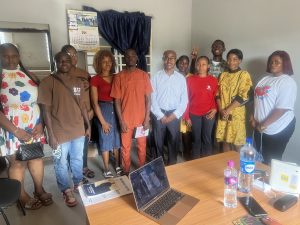An expert’s prescription on navigating the landmines of the business sector in times of uncertainty. By Silas Ifeanyi

All businesses are not only threatened by the Covid-19 pandemic but by emerging technologies that are causing massive disruptions to businesses and peoples’ lives. With the rising deployment of new payment systems such as Opay, Paystack, Flutterwave, Interswitch, E-Transact and a good number of other payment platforms and the CBN’s decision to grant banking licenses to MTN and Airtel to operate as Payment Service Banks (PSB), Nigeria is gradually inching towards full digital payment that will replace paper money or what experts like to call paperless financial environment. If you add this to the profusion of Automated Teller Machines (ATMs) and Point of Sales (POS) kiosks everywhere, you’d really understand the kind of transformational change taking place in the global financial landscape. When all these eventually mature, the traditional brick-and-mortar banks as we know them today may cease to exist. These innovations are being simultaneously witnessed all over the world. In Shanghai, China, it was recently reported that all you needed to own a bank account is to have a WeChat app, the Chinese equivalent of WhatsApp. With that, you not only own your bank account with the ability to carry out multiple banking payment transactions including cross border settlements but literally own your own bank! Facebook has just rebranded and is now known as Meta which is a step towards fulfilling Mark Zuckerberg’s ambition of creating an alternative universe known as Metaverse. One of the service products that would be offered in the Metaverse is a digital commerce that will allow Facebook community of friends to operate their own digital currency and exchange outside the formal banking sectors and beyond international borders. My effort here is not only just to show how all these will revolutionize our commerce and payment systems but how they will cause massive disruptions and threats to existing companies in the industry even more than those posed by Covid-19 pandemic.
In the auto industry, Elon Musk’s Tesla that makes electric vehicles has forced the traditional auto vehicle makers that run on fossil fuels to diversify into making electric vehicles and forced oil majors to start investing heavily in renewable energy to cushion the effect of the radical drop expected when electric vehicles completely take over. Although this presents future threats, some oil companies already see the opportunity in the gas that would power the electric vehicles chargers that will replace petrol/gas filling stations and are redirecting investments towards capturing that new market. Those who succeed would have turned the future existential threats they face today to opportunities.
BUSINESS THREATS
Business threats refer to all those factors that can adversely affect organizations and could subsequently prevent them from achieving their set goals or may even put them out of business completely. For instance, the floods that affected many rice farmers in Zamfara, Kebbi, and other Nigerian states last year, the war against Boko Haram in the northeast states of Nigeria, the bandits’ activities in the northwest and north central, the activities of the unknown gunmen and sit-at-home orders by the Indigenous People of Biafra (IPOB) etc. constitute local threats to many businesses in Nigeria. On the global stage, the Covid-19 pandemic that has disrupted business worldwide and created unprecedented value chain problems in the world, happens to be the single most devastating threats to many businesses all over the world since the World War II.
WHAT MANAGERS DO TO OVERCOME THREATS
When managers are faced with existential threats such as the Covid-19 pandemic, they go into planning to formulate strategic responses to the threats to remain in business. This requires the managers to evaluate organization’s current situation and then develop appropriate strategies or steps in response to neutralize the threats. In evaluating their organization’s business prospects, managers face three central questions:
- What is our company’s present situation?
This prompts the mangers to evaluate their entire industry conditions such as current company performance, market standing, present resources, capabilities, and weaknesses (SWOT Analysis), competitive pressures etc.
2. Where does the company need to go from here?
This pushes managers to make choices about direction that the company should be headed; what new business or customer needs that the company should endeavor to satisfy; what changes in business makeup are needed etc.
3. How should it get there?
This question challenges managers to craft and execute strategies capable of moving the company in the intended direction, growing its business, and improving its market and financial performance.
WHAT’S THE COMPANY’S PRESENT SITUATION?
Strategic formulation begins with managers analyzing the current factors within and outside the organization that will hinder it from meeting its business goals now and in the future. S.W.O.T. Analysis and Five Forces model are two techniques that managers deploy to analyze these factors. Because of the limitations of the topic of this paper, I will only attempt to broach these techniques as they affect turning threats into opportunities.
SWOT Analysis – The first step in strategy formulation is to carry out the SWOT analysis of your organization to help you identify your Strengths (S), Weaknesses (W), Opportunities (O) and Threats (T). While things like your brand name (MTN for instance), brand reputation (UNN for instance), strong product line, skilled workers etc. could form your potential strengths, poor marketing plan, poorly crafted strategy, inadequate human resources, employee skill gaps etc. could form your potential weaknesses. Potential threats can be caused by downturn in the economy resulting low sales, change in consumer tastes, introduction of new technology etc.
On the other hand, potential opportunities exist when opportunity to exploit a new market exists, when opportunity to widen products range exists, when an organization can deploy a new technology, when it can be the first to race to the market with new product or service etc. Looking critically at the SWOT analysis, one can clearly see that Strengths and Weaknesses are internal to the organization while Threats and Opportunities are external.
For instance, brand reputation (strength) and poor strategy (weakness) as stated above are internal and within the organization but change in technology (threat) and opportunity to exploit new market (opportunity) are external to the organization. Managers will need to understand these factors and other external forces that could be of potential threats to their business to craft and execute winning strategies to overcome those threats and possibly convert the threats to opportunities. Therefore, planning is important to organizations that want to succeed. For as they say, ‘those who fail to plan, plan to fail.’
The Five Forces Model
Although the focus of this lecture is on how to convert challenges posed by the current global Covid-19 pandemic to opportunities, it is important that we look at a set of forces and conditions outside the organization’s boundaries that have the potential to affect the way the organization operates. These forces change over time and thus present managers with threats (challenges) and opportunities. As a result, it is important that we look at Michael Porter’s Five Forces Model popularly known as the five competitive pressures. This is a well-known model that helps managers to isolate forces in external competitive environment that are potential threats to their organization to eliminate them or turn the threats to opportunities. Recall that when we looked at the SWOT analysis above, we saw that opportunities and threats are external to the organization and we ended up by concluding that the aim of all managers is to convert every threat to opportunity. Should mangers study these competitive pressures? Competitive pressures affect the profits that organizations can make. So, when managers are planning on how to convert threats to opportunities, it is important that they know how intense the competitive pressures are in their industry, otherwise, they may fail to realize their goals. Because the character, mix and subtleties of the competitive forces operating in a company’s industry are never the same from one industry to another, the most common and widely used tool for systematically diagnosing the principal completive pressures in the market and assessing the importance and strength of each is the Five Forces Model.
Let us briefly look at them:
- Rivalry among competing firms This measures the intensity of competition between rivals and their jockeying for better market position, increased market share, competitive advantage and so on. In fact, for them, the marketplace is a competitive battlefield and rivalry increases as number of firms increases. If the rivalry is very intense, some organizations may result in cutting prices or lowering standards to attract more buyers. Can anybody see this happening in the Nigeria university system? I heard that when God Is Good Transport opened an Office at Nsukka and slashed fare from Nsukka to Lagos, Peace Mass Transit and others responded by lowering their fares too to beat the competition. At the national level, we all saw how MTN switched to per second billing from per minute they billed even if your call lasted only for a tenth of a second to counter Globacom’s per second billing strategy. This invariably affected MTN’s bottom-line since they now charged less for the same length of calls. The same thing happened in the SIM card war such that some now gift SIM cards loaded with airtime when you register. At the International level, we have intense rivalries between automakers as well as between GSM phone makers. As a matter of fact, this jockeying for a better share of the market happens in all industries and that’s why it is important that any organization that wants to convert the threats posed by the pandemic to opportunities must know what happens in the new market that it may be entering. If at the planning stage, it failed to craft strategies to counter rivalry, it risks being put out of existence. In the 80s and 90s, Compaq Computers was one of the largest Personal Computer (PC) makers in the world. In fact, it performed the engineering feat of being the first company to legally reverse engineer the IBM Personal Computer and became the first to produce computers compatible to IBM PCs. But at the turn of the century, it struggled to keep with up with price wars against low budget Dell PCs and was eventually acquired by HP in 2002.
ii. Competitive pressures associated with new entrants The easier it is for companies to enter an industry especially when there are low barriers to entry, the more likely it is for that industry’s prices and profits to be low. In Nigeria, for instance, we all know that the entry barriers to telecommunication industry is high and that’s why despite the high profits recorded in the industry, we still have 4 national carriers since 2001 that the first license was issued. To date, consumers of their services remain at their mercy. However, where the barriers to entry are low, it becomes free for all and that will lead to low prices and therefore low profits for firms operating in that industry. I remember clearly between 2010 and 2012 when there were over seven thousand Bureau De Change (BDC) operators in Nigeria that had access to unlimited amount of foreign exchange through the commercial banks. No BDC made more than twenty kobo (20k) per dollar which made many BDCs, to stop foreign exchange (fx) trading, all together. The reason was nothing but low entry barriers which made it easy for non-players to get licenses overnight. Airline business is one industry with high entry barriers and that’s why they can afford to charge high prices. Compare this to land transport where anyone can start his own transport business today!
iii. Competitive pressures from companies offering substitute products Companies in one industry come under intense competitive pressures from the actions of closely adjoining industry when buyers view the products of the two industries as substitutes. For instance, the marketers of sugar face competitive pressures from the makers of artificial sweeteners. GSM companies all over the world are facing intense pressure from those companies that provide internet calls like Facebook, WhatsApp, Viber etc. Even Newspapers are facing competition from online bloggers and cable news providers. Competitive pressures from substitutes are stronger when substitutes are readily available and especially when substitutes are attractively priced. Compare making international calls through a GSM line and through internet-based app like WhatsApp. Every call successfully made through the social media platforms is a loss to the main GSM service providers. I wouldn’t know how much handouts in the Nigeria universities have affected authors and publishers, but I assume that competitive pressure exists between them and if it is true, the authors and their publishers would be struggling to make it. Some of you have written books can testify better
iv. Competitive pressure stemming from buyer bargaining power Individual consumers, except they are big, or industry leaders rarely have much bargaining power but if they collaborate and form a union, they can push down the prices that sellers are willing to sell to their advantage. I recall when Nigeria banks charged N5 per every N1,000 as commission on turnover (COT), our group never paid more than 50 kobo per every N1,000 or 10% of what everyone else paid. We succeeded because we understood how this competitive pressure worked. The result is that banks made less from our big volumes (their losses were our gains). I should think that an institution like the University of Nigeria, Nsukka would apply this pressure in negotiating banking terms with their bankers. Nothing stops the university from paying zero monthly maintenance fees and they would still be sought by all the banks.
v. Competitive pressure stemming from supplier bargaining power When major suppliers to an industry have considerable leverage in determining the terms and conditions under which businesses are to be consummated, then they can exert competitive pressure on one or more rival sellers and even buyers. Take the Organization of Petroleum Exporting Countries (OPEC) for instance. It can decide, as a cartel, to cut production to force the price of crude oil up. By doing so, they exert competitive pressure on non-OPEC remembers who any option wouldn’t have than to cut prices and lose money. Microsoft and Intel which supply PC makers with products do not only charge PC makers premium prices but also pressure them to display their icons prominently in their systems. This affects rival PC makers who must turn to them or lose market share.

WHERE DOES THE COMPANY NEED TO GO FROM HERE?
Having evaluated the organization’s current situation through two useful popular management tools – the S.W.O.T. analysis and the five forces model, the next step is for the managers to make decisions about the direction their company should be headed; what new businesses they should get into; how they can change their offerings to survive the harsh business environment that they have found themselves in; new customer needs that they should endeavor to satisfy; what changes in business make up are needed etc. Managing Change In order to breakdown resistance to the strategic vision, managers must provide compelling rationale for the change they want to introduce. If the employees fail to understand the rationale behind the change, they are likely not to buy into the new vision and will do anything to resist it. To succeed in carrying the entire organization along, management must address employee concerns head-on, calm down fears and provide updates as events unfold. These steps are necessary to mobilize support for the change and win commitments from all involved to help successfully execute the vision. Converting threats posed by the Covid-19 pandemic to opportunities means executing new vision and change and to succeed, managers would not only be familiar with steps that will lead to a successful change management but develop skills to manage them effectively. This is because change is disruptive in nature. Deciding how to change an organization is a complex matter, not in the least because change disrupts the status quo and poses threats to some comfortable positions, prompting employees to resist attempts to alter work relationships and procedures. Of all the works of management experts on managing change, I find John Kotter’s eight steps for change management most compelling, and I have personally successfully used it to implement changes at difficult periods in our organizational life. Many people and organizations have also used some elements of Kotters’s work to successfully implement changes, probably without even being aware of it. We shall briefly discuss them below:
1. Create A Sense of Urgency – Creating a sense of urgency helps to galvanize people to action because it will help them see the need for change through a bold, inspirational statement that communicates the importance of acting immediately as in if we don’t change, we perish! It is, therefore, important that everybody involved understood the reasons for the change and the importance of acting immediately, so that the motivation in each of them can be aroused. Some of us here are old enough to remember the powerful committee that General Ibrahim Badamosi Babangida (IBB), a one-time military President of Nigeria set up in 1986 to conduct national debate to convince people on the benefits of the Structural Adjustment Program (SAP) which was part of his strategy of getting the people to accept to take the short period of pain that SAP will bring. The message came at a time that the people were facing hardship in all fronts with the scarcity of essential commodities and international credit closed for imports. The message was so powerful that the Nigerian people in unison rejected the IMF loan that was supposed to finance the program but accepted the strict IMF conditionalities that would bring pains and sufferings to them. That’s what a powerful message conveying a sense of urgency does to people in organizations.
2. Build A Guiding Coalition – To successfully implement a change such as orchestrating a strategic response to threats posed by Covid-19 pandemic, it becomes important to build a coalition of believers who will help you drive the change. It is important to understand, that no matter how reasonable that your sense of urgency may appear, it is not everybody that will have a complete buy in. To succeed, you need to create special change angels that will carry the message to all parts of the organization and guide the implementation. Even in the university here, I am sure that the Vice Chancellor has this team that serves as his kitchen cabinet. Once any policy is to be introduced, he gets them to make contacts to ensure minimal resistance when the new policy is rolled out. I have seen this work in my social groups and even in my locality.
3. Form A Strategic Vision and Initiatives – Clarify how the future will be different from the past and how you can make that future a reality through initiatives linked directly to the vision. Before forming a strategic vision on where the organization is headed, it is important to understand the pressures that are driving the change. It could be the emergence of a new leadership which is an internal pressure or external pressures like emergence of a new technology, a shift in consumer behavior or other things that have the capacity to affect the organization negatively. In our case here, we know that the pressure is external, the Covid-19 pandemic that has affected business operations and outlooks all over the globe. Our challenge is to form strategic vision and initiatives that would help our company or companies in our industry not only to survive but to turn threats posed by the pandemic into opportunities. A strategy is a descriptor for a set of actions that will be used to achieve our vision. Strategy-making and strategy-execution process consists of five steps:
a. Developing a strategic vision plan
Where the company needs to head to, what its future product, market, customer, technology focus should be? Whereas Vision portrays a firm’s future business scope – where we are going to, Mission on the other hand totally describes company’s present business and purpose – who we are, what we do and why we are here. It is often necessary when implementing a disruptive change to change the company’s Mission and Vision statements to align it with their new vision and business focus. This is common with big corporations all over the world as they compete for business spaces outside their core areas. Scenario Planning Sometimes, it becomes extremely necessarily to do a scenario planning which tries to identify some possible future threats that could disrupt their business to help them prepare how to respond to the threats when they occur. Shell Petroleum which is most associated with pioneering scenario planning deployed to work in 1984 when oil price rose $30 per barrel, and they feared that it could crash. Their managers were asked to anticipate what would happen if oil price did plummet to $15 per a barrel. The managers came up with many cost cutting plans like cutting exploration costs by investing in new technologies, accelerate investment in cost efficient refining facilities and close unprofitable gas stations. By mid 80s, oil prices did collapse, and Shell was already well prepared for such that by 1990, it has doubled in size.
b. Setting objectives
The endgame, bottom line, and purpose of existence of every business organization except for Non-Governmental Organizations (NGOs) is to make profit. To achieve this objective, organizations break this objective into short term goals. Some of the goals are quantitative while some can be qualitative depending on the offerings. For goals to be purposeful they must be S.M.A.R.T. – Specific, Measurable, Achievable, Realistic and Time bound.
c. Crafting a strategy to achieve the objective
This helps to move the company along the strategic course that management has charted without which the company won’t be focused. I have stated above that a strategy is a descriptor for a set of actions that will be used to achieve the organization’s goal.
d. Implementing and executing the strategy efficiently and effectively. This involves following through the course of actions that have been successfully initiated.
e. Evaluating and initiating corrective actions It is very important at every stage to evaluate how the strategy is working and initiate corrective action where necessary.
4. Enlist A Volunteer Army
Large scale change can only succeed when massive number of people rally around the common purpose. To get people’s buy in, you need to communicate, communicate, and communicate. If there is the need, communicate in everyday language that can make people imbibe the new message and make it their battle cry. During President Buhari’s first coming as a military Head of State in 1984/85, he introduced WAR AGAINST INDISCIPLINE which was aimed at attacking social maladjustment and widespread corruption. It meant a change of attitudes and the way the people lived. To get massive number of people to rally around it, many programs that highlighted the societal ills and their consequences were aired before major national news broadcast. In addition, posters and radio jingles in different languages were used to communicate to the people. It didn’t take long for everyone in the country to know about the program. That was the same work that Prof Jerry Gana did for another military government in the National Orientation Agency that went with the acronym – MAMSER -Mass Mobilization for Self-Reliance, Social Justice, and Economic Recovery. He went around as the government’s “vuvuzela” drumming government’s new initiatives (changes) into the ears of the ordinary people. That way, people were mobilized.
- Enable Action by Removing Barriers
One of the changes that swept the corporate world in the 90s was Business Process Re-engineering (BPR). It aimed at helping organizations fundamentally rethink how they do their work to improve customer service, cut operational costs, and become world-class competitors. Bureaucracies and inefficiencies are clogs that hamper speed of workflow. One of the things that change management looks at is how to remove all barriers that affect workflow. One other way of increasing efficiency is to empower employees. Employee empowerment is a management philosophy that emphasizes the importance of allowing employees to make independent decisions and act on them. This helps employees do better jobs in the moment while growing into more productive members of the organization. Empowerment is one of the best motivation tools.
- Create Short Term Wins
By creating short term wins, you let people see that their efforts are yielding some results. People feel more motivated when they see some progress in the activities they do. To achieve this, it is advised that employees are given short term goals and rewards given to those who meet and or exceed their goals. When IBB came into power in 1985, he promised huge changes from the past and one thing he did was to abrogate Degree 4 under which Tunde Thompson and Nduka Irabor were jailed by the previous government. He subsequently released them from prisons. The nation cheered and jubilated. That way, he made many people buy into his change. In our own organizations, when we are implementing a change that we want to disrupt the market, we set milestones (goals) that will get rewarded daily, weekly, and monthly.
- Sustain Accelerations Don’t slow down.
Press harder after the first success. Be relentless in initiating change after change until reality is achieved. Remember that change is uncomfortable for most and it is, therefore, normal for people to resist it. 8. Institute A Change Finally, make change part of the culture. Incorporate the change into the company’s culture, core value and make it part of its DNA. Integrating change into your organization’s culture will prepare your team for future changes. It’s up to managers to foster a suitable environment for organizations to go through smooth change processes.
FAILURE TO INNOVATE (CHANGE) MEANS DEATH
In the corporate world, failure to innovate to fight external threats is a death sentence. The world is littered with former big companies that failed to change and got their fingers burnt. Locally we can name a couple of companies that disappeared because of their failure to respond to threats. i. The Nigerian Telecommunications ltd was a telephone monopoly until the 80s when it became Nigerian Communication Commissions which allowed other smaller players in. It even pioneered the first mobile phone in Nigeria but failed to obtain GSM license when the Nigerian government auctioned them at the turn of the century. I am not sure that anybody born after 2001 or even a bit earlier would understand how powerful that NITEL was. Now, MTN, Globacom, Airtel and 9 Mobile have buried it deep down the grave. ii. Eastman Kodak was the biggest photo film makers in the world. Given that Kodak’s core business was selling film, it is not hard to see why the last few decades proved challenging. Cameras went digital and then disappeared into cell phones. People went from printing pictures to sharing them online. Today, Kodak is no more as it was known before. iii. As we saw above, under the 5 competitive pressures, Compaq was the largest sellers of PCs in the world but failure to innovate left it open to aggressive takeover and it was acquired by HP in for $25 billion in 2002. TURNING COVID-19 THREATS TO OPPORTUNITIES Because every business face threats from numerous sources, that’s why we started with S.W.O.T. analysis to show how companies can look at their internal strengths and weaknesses as well as the external threats and opportunities facing them. It was the same threats that made us look as at the five competitive pressures that can become real threats for the company. Now it is time to connect the dots. How do we convert threats imposed by the Covid-19 pandemic to opportunities? My best take is to look at those responded successfully to the threats and ended up increasing their market shares and values in this pandemic.
1. Zoom Video Communications is an American communications technology company that provides video telephony and online chat services through a cloud-based peer-to-peer software platform and is used for teleconferencing, telecommuting, distance education, and social relations. As a result of social distancing required to avoid covid infection, Zoom took the advantage to grow its business customers base to 470,000 and was valued at over $100 Billion from less than $20 billion the previous year. I am sure that at least one in two participants here has used Zoom for one conference or the other. 2. Nigerian Banks. Before the pandemic, many banking halls were crowded like busy markets. Because of the requirement of social distancing by the Nigerian Center for Disease Control (NCDC), most banks deployed apps that enabled customers to carry out most of their transactions in the comfort of their homes and offices. Many banks now even discovered that they didn’t need the number of staff on their pay roll and attempted sacking them if not for the intervention of the CBN because of the public outcry. Be sure that banks will still find ways around it to cut cost and make more money. 3. Pharmaceutical Companies. The pandemic became huge opportunities for pharmaceutical and allied industries all over the world to make not only drugs to treat covid patients but make in large quantities such other stuffs like hand sanitizers, disinfectants, ventilators, personal protective equipment, surgical masks, hand gloves etc. Those who whose vaccines got the required regulatory approvals became instant billionaires. 4. Work from Home Employees. The covid pandemic has made many companies especially in America and Europe to know that they don’t need physical offices to exist, and their employees don’t have to be in same physical locations. This discovery has enabled many western countries to source cheap labor from Southeast Asia and some Middle East countries. These workers all work from home and the result is extraordinary reduction in overheads and rent costs which will naturally need to increase bottom-line. 5. Ordinary Nigerian Hustlers. The pandemic turned every Nigerian hustler into a face mask maker. In the traffic I not only see all kinds of masks but also watch as brisk businesses are consummated. They have made masks that carry the English Football team logos which their supporters pay anything to have.
Being a speech at the inaugural University of Nigeria Business Promotion and Products exhibition Fair by Silas Ifeanyi Babaedem Bsc (UNN), MBA, University of Liverpool President Fund Trust Group and Chairmain, Asabana Suites & Hotels Ltd, Nigeria





